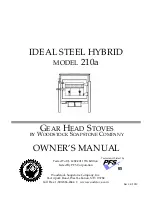
Hearth Sizing:
Clearances for your Ideal Steel Hybrid stove on the front,
back and sides must be taken into consideration when
determining the placement and size of your floor protection.
The floor protection must extend under any horizontal con-
nector pipe and 2 inches beyond each side of that connector.
PARALLEL HEARTH PAD
MINIMUM DIMENSIONS
A.
Floor protection in front of load door opening = 16”
B.
Protection to either side of the loading door/ash
door opening = 8”
C.
Floor protection non-loading door sides = 6”
D.
Floor protection behind stove (top vent or rear
vent) = 6”
Minimum hearth size in a parallel installation is 46”D x 38”W.
Recommended size is 48” D x 48”W or larger.
A 48” x 48” square hearth pad will allow for
6” behind the stove, 11” on either side, and 18”
in front of the stove. The hearth pad must have a minimum R value
of 0.41 (1/2” of “cementboard' covered with 1/4” of tile or stone).
CORNER HEARTH PAD
Minimum hearth size in a corner installation must be 54.5”x
54.5” (with the front corner cut off).
NOTE:
To achieve the
minimum hearth dimension, the stove must be top vented.
Calculating a Corner Hearth Pad (per NFPA 211):
A=C x 1.414 + W/2 + D + Front Hearth Requirement
A =
distance from corner to the front of the hearth pad
C =
clearance from rear corner of appliance to wall (rear heat
shield is recommended but not required)
1.414 =
a constant
W/2 =
one half the appliance width (12.625”)
D =
appliance depth (23.5”)
Front Hearth Clearance
= 16”
Example:
Ideal Steel with the Rear Heat Shield & Pipe Shield
A= 6” x 1.414 + 12.625 + 23.5”+16”
A= 60.5”
WALL PROTECTION
The Model 210 Ideal Steel Hybrid stove has been tested to UL standards for clearances to combustible walls. The mini-
mum clearances to unprotected walls are as follows:
Minimum clearances with no heat shields to unprotected combustible walls:
From the back------------------ 14”
From the sides-------------------19”
Do not assume that a wall is not combustible because it has a nonflammable surface
. A wall with any combustible
materials in it must be considered combustible. For example, a brick wall attached to wood studs is considered a com-
bustible wall. Over time, heat will pass through bricks and heat the wood, lowering the ignition temperature of the
PARALLEL HEARTH PAD
Measurements taken from stove body
Stove Body Width 25.25”
Stove Body Depth 23.5”
A=60.5”
54.5”
54.5”
31.5”
33”
CORNER HEARTH PAD
Ideal Steel Hybrid shown above
centered left to right
7
C
A
B
B
D
Door Opening
C
60.5”
Grayed area represents the front hearth clearance
requirement of 16”, which must extend 8” to the
right and left of the loading door opening.












































